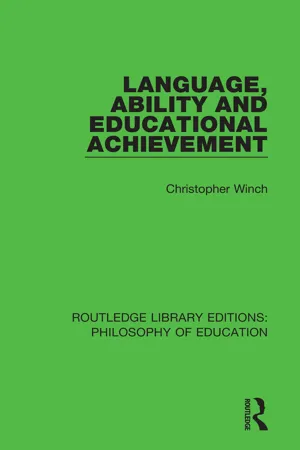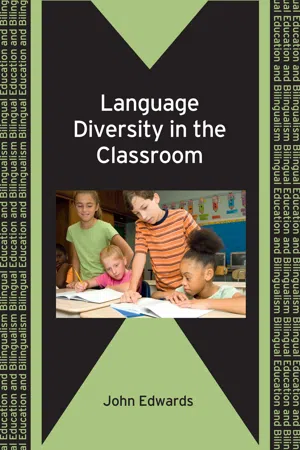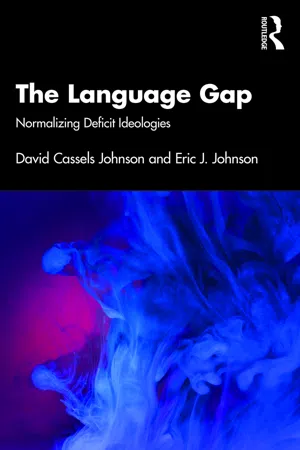Languages & Linguistics
Deficit Approach
The Deficit Approach is a perspective that views language differences as deficiencies or problems that need to be fixed. It assumes that there is a standard or "correct" way of speaking and that any deviation from this norm is a deficit. This approach has been criticized for being biased and for ignoring the cultural and linguistic diversity of individuals and communities.
Written by Perlego with AI-assistance
Related key terms
Related key terms
1 of 4
Related key terms
1 of 3
3 Key excerpts on "Deficit Approach"
- eBook - ePub
- Christopher Winch(Author)
- 2016(Publication Date)
- Routledge(Publisher)
CHAPTER 7 Theories of cultural and verbal deficitPsyehometrically based theories of ability and educational achievement give us one view of how society is organized into classes on the basis of natural, inherited, general intellectual ability. Theories of cultural and verbal deficit focus on the culture and language of different social groups and the way in which this affects their education. Some groups are said to be "culturally deprived" in relation to other groups. This means that the knowledge they have, their means of gaining it, and their means of expressing it are inferior in comparison with other groups. This, in turn, drastically affects their ability to benefit from a formal education.Appreciation of the importance of language is fundamental to the understanding of human societies, and it is not surprising to find that views on language and language use, and on their relation to different social groups, play a vital part in theories of cultural deprivation. One can go further and say that theories of language deficit are a subspecies and even form the core of these theories. Language deficit theories maintain that poor language and poor social conditions go together and that poor language, especially, is responsible for poor educational achievement. What "poor" means in this context is different from its meaning in the phrase "financially poor," although there would be, in most versions of the theories, an empirical association between the two types of poverty. Linguistic poverty is above all, a poverty in what can be talked about and how it can be expressed.It is not surprising, either, to find that these theories are associated with a "different types of mind" view, which we found in Plato's picture of human nature. In fact, I.Q. theory and verbal- or linguistic-deficit theories have a close but variable relationship. Verbal-deficit theories place great importance on language rather than on tests without an obvious linguistic content. They have, however, tended to rely heavily on testing and quantitative measurement as a means of assessment. What is more, they are often compatible with I.Q. theory. That is, it is perfectly possible for verbal deficit and low I.Q. jointly - eBook - ePub
- John Edwards(Author)
- 2009(Publication Date)
- Multilingual Matters(Publisher)
Indeed, even limited gains within education ought not to be taken for granted. A recent example of the volatility here is found in the rejections of bilingual education programs in some parts of America, the assertion being that bilingual education has gone too far in promoting and sustaining minority languages, that an undesirable balkanization must be resisted and so on. Flores (2005) discusses the links between such programs and linguistic disadvantage for the Hispanic children who constitute the great bulk of the bilingual education constituency in America. Bedore and Pe&ntilda (2008), Commins and Miramontes (1989), Delgado-Gaitan (1992), Gifford and Valdés (2006) and Jiménez (2000, 2006) investigate further the continuing 'deficit' assumptions that are made about Hispanic children — and others whose maternal language is not English — by teachers and some researchers. Related events beyond the schoolroom include the occasional but recurring efforts to formally designate English as the official language of the United States, and of the success of such efforts at the state level. More than half of the 50 states now have official-English legislation. Several of these, it is true, have designated English as co-official with another language, as have some American territories; in one case — the Northern Marianas — trilingualism is official (Chamorro, Carolinian and English).As well as acknowledging that reasoned academic argument may not always penetrate as far or as quickly as we would wish, it is clear that the 'limited-gain' argument I have cited above also applies within the hallowed groves themselves. The Feagans and Farran (1982) collection, already mentioned, brought together some well-known writers, all of whom were well aware of the latest research bearing upon linguistic difference-and-deficit matters; well aware, that is, that the best psycholinguistic opinion of the time supported a 'difference' point of view. Yet, the editors noted in the preface that the deficit model became untenable not only because of 'new perspectives', but also because interventions based upon it did not work very well. The possibility is held out, in other words, that only strategies were misguided, not underlying assumptions. One of the chapter authors (Blank, 1982) considers that both difference and Deficit Approaches have difficulties, but fails to make clear that the difficulties are not of equal force: the linguistic objections to the fundamentals of the deficit position are overwhelming, while the sorts of 'difference' problems she discusses have to do with the assessment of appropriate ranges of skills for different social groups.3Blank also suggests that deficit theorists have typically concerned themselves with semantic issues, difference theorists with syntax. Again, this inaccurately weakens the anti-deficit case, for it implies that the model might, after all, retain some validity. Tough (1982) argues here for a stereotypically 'deficit' view of speech patterns in working-class homes, an argument she had made earlier (Tough, 1977) and which she continued to make (Tough, 1985). Another contributor also muddied the picture by claiming that disadvantaged children do have deficits, which are not linguistic but are rather deficiencies of knowledge; these lead, then, to smaller vocabularies (Snow, 1982). While at first blush it would seem that matters of vocabulary are - eBook - ePub
The Language Gap
Normalizing Deficit Ideologies
- David Cassels Johnson, Eric J. Johnson(Authors)
- 2021(Publication Date)
- Routledge(Publisher)
5 Normalization of Deficit Language Ideologies DOI: 10.4324/9781315561554-5 In previous chapters, we leveraged the research from linguistics, sociolinguistics, and anthropology to examine language gap theory and research methodology, and how findings have been appropriated by government agencies, philanthropic foundations, and professional associations. This chapter takes a closer look at the connections between those foundations and the media, and their role in the circulation and normalization of language deficit ideologies. As was discussed in Chapter 2, language ideologies rely on broader prescriptive norms that influence attitudes towards different language varieties (and their speakers). Language ideologies encompass language attitudes (Ryan et al., 1982) but are associated with clusters of attitudes that perpetrate, and are perpetuated by, systems of power. Definitions for language ideology vary, but Woolard & Schieffelin (1994) offer a helpful summary and argue that a fundamental distinction lies between those definitions that take a neutral stance and others that take a critical stance, the latter tending to embed “strategies for maintaining social power” into the definition (pp. 57–58). Their definition builds on Rumsey (1990), who defines language ideology as “shared bodies of commonsense notions about the nature of language in the world” (p. 346). Language ideologies position certain linguistic features as more natural or normal, especially those popularly believed to align with prescriptive grammatical norms
Index pages curate the most relevant extracts from our library of academic textbooks. They’ve been created using an in-house natural language model (NLM), each adding context and meaning to key research topics.
Explore more topic indexes
Explore more topic indexes
1 of 6
Explore more topic indexes
1 of 4


